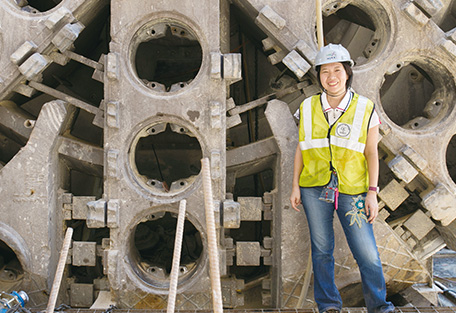Japan's Official Development Assistance White Paper 2013
Stories from the field 06
Madam, This is Our Metro!
– Female Civil Engineer in Charge of Subway Construction Quality and Safety Management in India –

Ms. Abe stands in front of a shield machine transported from Japan. (Photo: Shuhei Fujita)
Bangalore – home to branch offices of major international high-tech makers, it is a city sometimes called the “Silicon Valley” of India. Rapid economic development and an explosive increase in the population, soon to be 10 million people, have resulted in chronic traffic jams within the inner city. To mitigate this problem, construction began in July 2007 to build a “Bangalore Metro.” The railway is set to be 42 km in length with 8 km passing underground beneath the city center and the rest of the regions being served by above ground rails. Once completed, the urban environment will improve and people will be able to reach their destinations on time, no longer forced to live at the mercy of traffic jams. Furthermore, thanks to in-station and in-car security systems, even a female can ride alone safely, which promotes women’s participation in the workforce.
ODA loans from Japan account for approximately 20%, or ¥ 64.5 billion of this ¥ 306.8 billion project. Working at the construction site is a woman many refer to as “the Madam.” She is Ms. Reiko Abe. She is an employee of Oriental Consultants Co., Ltd., the company overseeing construction, and is a specialist in civil engineering. She has been responsible for local work on quality control and safety management since October 2010. This is her second project in India after a tenure working on the “Delhi Metro” from 2007. She commented about the culture gap she felt while interacting with her Indian subordinates the first time she worked in the country.
“First of all, there is no concept of being on time. Even for a meeting, people are comfortable being 30 minutes late. When I got mad about that, they just said, ‘Why are you angry Madam? Now, now, let us have some coffee.’ But if one cannot manage something as fundamental as time, the entire management structure will be slipshod. So I didn’t give up, I kept being angry.”
Even if she continued to be told that she often got angry, she came to understand the character of the Indian’s. They were prideful and ambitious. Once they were convinced of something, they worked with passion. They loved new challenges. Ms. Abe came to respect these traits, and became skilled at managing her subordinates.
There are tens of thousands of workers employed in hard labor for the construction of the metro. The local language of Bangalore is Kannada, but many of the workers speak other languages having migrated from other regions for the project. Often, they can neither read nor write. Methods first used in the Delhi Metro project to protect the safety and health of these illiterate workers are being applied here as well.
The underground construction work may cause the movement of foundational ground that can trigger roads’ sinking and pose the concern that nearby buildings may be tilted. To draw attention to this, the project is using a method devised by Kobe University, in which three-color traffic light communicates information based on movement measurements. This has made safety information “visible.” Anyone can see that a change has occurred even if they do not speak the local language when they see the normally green traffic light switched to yellow or red.
Dust prevention is another important issue for the health of workers at construction sites. Yet workers here do not commonly wear masks. Ms. Abe thought about how she could get the workers to wear masks suitable for the amount of dust in the air, and she hit upon an idea of using a system developed by Yamaguchi University to measure aerosolized dust using smartphones. Indians love smartphones, and the trial was very successful, with local engineers now going out of their way to measure dust. Dust distribution maps were set up within stations, and measured dust levels were displayed by green, yellow, and red plates. The question of which mask to wear can now be answered with a single glance. Additionally, doctors were called to construction sites, and workers were given explanations about the seriousness of dust problems. The attitude towards dust changed.
The new technology introduced by these projects into India have been adopted by Delhi Metro Rail Corporation. They are being used for the construction of the Bangalore Metro, showing their worth as tremendous achievements of the projects implemented by Japan.
Bangalore continues to suffer traffic jams. Ms. Abe recalled one time when she was riding an auto rickshaw during a day off. Construction for the metro had made the traffic jam worse. The driver drew Ms. Abe’s attention to the metro.
“Madam, this is our metro! Isn’t it wonderful!?”
Hearing the driver talking about the metro with such pride filled Ms. Abe with heartfelt joy. The driver continued,
“By the way, Madam, do you have a metro in your country?”
The Bangalore Metro is set to open in March 2015.

Ms. Abe (center) gives technical guidance on safety. Workers wear different colored helmets depending on their position or task. (Photo: Shinichi Akutagawa / Kobe University)
